________________
JULY, 1936)
ROYAL ANTHROPOLOGICAL INSTITUTE, INDIAN SECTION
Dr. Hunt reported the progress made since the excavations described by him in the JRAL, LIV, 1924. The most important work done was at "Maula Ali, South ", where, last May, twenty men of the Survey of India, working under Maj. Wauchope, opened fivo burials. Finds included the bones of a hare in pot; bovine teeth ; much iron; pottery showing new features; and (in "M.A.S.V.") a fine gold spiral, with a large number of minute gold rings. Other rings were of silver, plated with gold, as in “Raigir III," see previous Report). These burials differed in type from those of Raigir and elsewhere in that the Cist slabs were vertical, and overlapped at the ends. In the north slab, a large round hole had been out, bringing these underground burials into line with the surface "Holed Dolmens" of Rajunkalur, described by Meadows Taylor and compared with similar Holed Dolmens of France.
In May 1923, further investigations were made by Mr. L. Munn and Dr. Hunt into the ancient Iron Industry of the Hyderabad State. The more this question is studied the more clearly does it come out that no limiting date can be placed on the smelting of iron in S. India. Continued study of the literature of the subject yields little, though excellent descriptions of surface conditions are given by the older writers. Destruction of these remains is rapid, thoir chief enemy being the cultivation of castor seed. At least six distinct types of burials can be distinguished and the total period covered must extend to thousands rather than hundreds of years. Some types must be far older than others, but before any attempt at "sequence dating " can be begun, there must be much organised and careful excavation. So far, we have not even distinctive titles for the various types. All finds must be labelled with their sites of origin, latitude and longitude, and a clear description of the type of burial; for in many fields different types are mixed up. Many fine specimens, now in museums, are almost valueless by reason of insufficient data.
There is urgent need for the provision of some central collecting station where typespecimens of pottery, beads, rings, human and animal remains, articles of gold, silver, copper, and iron, etc., etc., can be collected for comparative study. England appears to be the natural place for this, but, so far, no museum affords the requisite housing space. The work of the "Beads and Pottery Committee" of the Royal Anthropological Institute shows that the importance of the subject is recognised.
On December 8th, 1925, Mr. A. M. Hocart, Archæological Commissioner in Ceylon, reac! a paper on "The Illumination of the Buddha."
In Mr. Hocart's view the Buddha's illumination affords valuablo materials for the study of the processes of evolution in custom and belief. The Buddha as spiritual king had to conform to the requirements of tradition. These demanded that he should be installed with certain rites such as were obligatory for a king. Some of these rites, such as fasting, were inconsistent with the doctrine of the Buddha. The queen had to be suppressed, yet a frag. ment of the ritual where the king takes a consort survives with a new interpretation. Thus 'We can study in this cycle that process of conflict and rationalization which is so familiar to psychologists.
1 Since Dr. Hunt's lecture, Mr. L. G. Clarke, of the University Museum of Archaeology and Ethnology at Cambridge has undertaken the housing of all material from 8. Indian burials.




